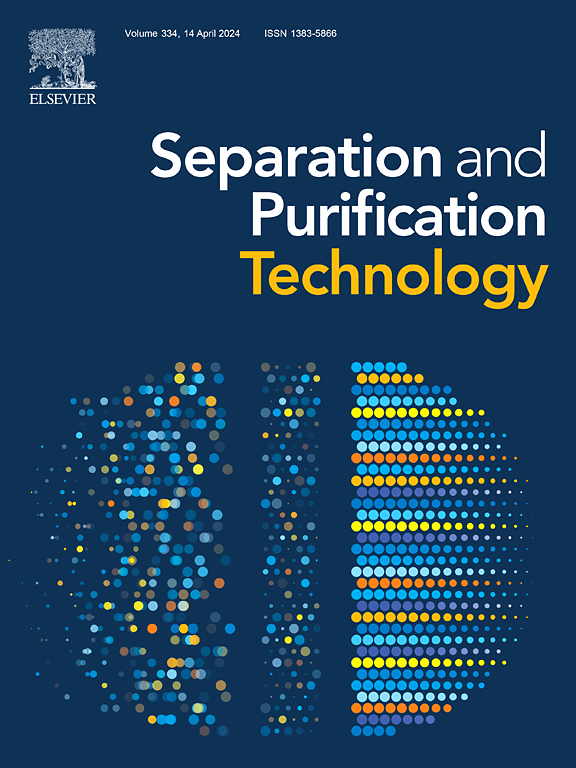具有丰富而坚固的v形纳米孔的仿生纳米限制催化臭氧氧化膜,用于快速降解污染物
IF 8.1
1区 工程技术
Q1 ENGINEERING, CHEMICAL
引用次数: 0
摘要
催化分离膜是一种很有前途的污染物降解和水处理材料,但其性能往往受到结构不稳定、催化效率有限、活性位点和物种利用率低以及水通量不足等挑战的阻碍。在此,我们提出了一种生物仿生设计策略,以 MnO2 为平台构建高性能纳米封闭催化臭氧膜。受杓兰和投手草结构特征的启发,我们通过一步水热法和掺杂工艺,设计出了具有 V 型纳米通道(平均尺寸:10.44 nm)的径向花形 FeCo@MnO2 膜。这种设计实现了极高的催化比表面积(110.0647 m2/g)和强大的结构稳定性,通过捕获和浓缩纳米孔内的污染物分子,实现了催化位点和活性物种的有效利用。在晶格中掺入铁和钴可增强电子传递,并引入多个氧空位,促进高氧化性单线态氧(1O2)的生成。在催化臭氧系统中,该膜以较高的反应速率常数(0.1199 毫秒-1)、25 毫秒的保留时间和卓越的水处理能力(50 升-米-2-小时-1-巴-1),对各种水污染物(50 ppm)实现了近乎完全的去除(100%)。这项工作为设计具有丰富活性位点和高效活性物种利用率的纳米催化膜提供了一种新颖有效的方法,为推动高性能膜材料在各种催化应用领域的发展提供了巨大潜力。本文章由计算机程序翻译,如有差异,请以英文原文为准。


Biomimetic nanoconfined catalytic ozonation membranes with abundant and robust V-shaped nanopores for rapid pollutant degradation
Catalytic separation membranes have emerged as promising materials for pollutant degradation and water treatment, yet their performance is often hindered by challenges such as structural instability, limited catalytic efficiency, low utilization of active sites and species, and insufficient water flux. Here, we present a biomimetic design strategy to construct high-performance nanoconfined catalytic ozonation membranes using MnO2 as a platform. Inspired by the structural features of Echeveria and pitcher plants, we engineered a radial flower-shaped FeCo@MnO2 membrane with V-shaped nanochannels (average size: 10.44 nm) via a one-step hydrothermal and doping process. This design achieves an exceptionally high catalytic specific surface area (110.0647 m2/g) and robust structural stability, enabling the efficient utilisation of catalytic sites and active species via the capture and concentration of pollutant molecules within the nanoconfinement. Lattice doping with Fe and Co enhances electron transfer and introduces multiple oxygen vacancies, facilitating the generation of highly oxidizing singlet oxygen (1O2). In a catalytic ozonation system, the membrane demonstrated near-complete removal (∼100 %) of diverse water contaminants (50 ppm) with a high reaction rate constant (0.1199 ms−1), a retention time of < 25 ms, and superior water treatment capacity (50 L·m−2·h−1·bar−1). This work provides a novel and effective approach for designing nanocatalytic membranes with abundant active sites and efficient active species utilization, offering significant potential for advancing high-performance membrane materials in diverse catalytic applications.
求助全文
通过发布文献求助,成功后即可免费获取论文全文。
去求助
来源期刊

Separation and Purification Technology
工程技术-工程:化工
CiteScore
14.00
自引率
12.80%
发文量
2347
审稿时长
43 days
期刊介绍:
Separation and Purification Technology is a premier journal committed to sharing innovative methods for separation and purification in chemical and environmental engineering, encompassing both homogeneous solutions and heterogeneous mixtures. Our scope includes the separation and/or purification of liquids, vapors, and gases, as well as carbon capture and separation techniques. However, it's important to note that methods solely intended for analytical purposes are not within the scope of the journal. Additionally, disciplines such as soil science, polymer science, and metallurgy fall outside the purview of Separation and Purification Technology. Join us in advancing the field of separation and purification methods for sustainable solutions in chemical and environmental engineering.
 求助内容:
求助内容: 应助结果提醒方式:
应助结果提醒方式:


